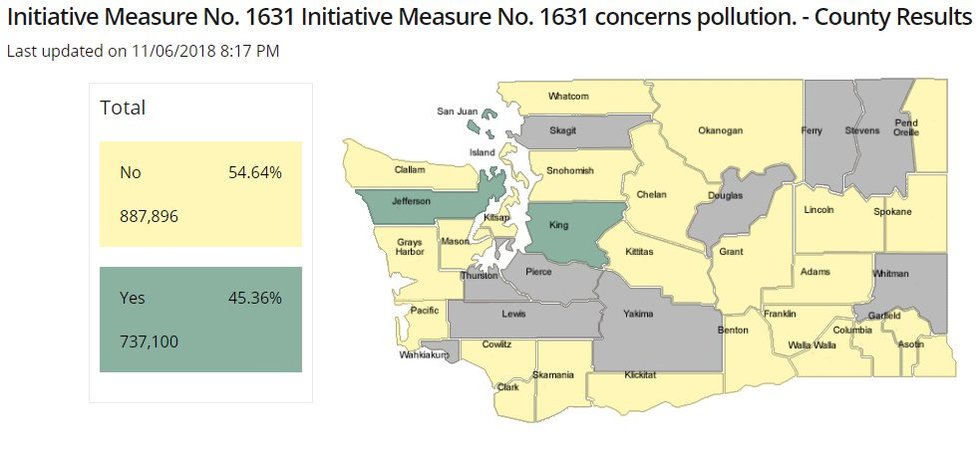Results from the U.S. midterm election are mostly in, and, when it comes to what they mean for the environment, they’re a real mixed bag.
On the plus side, the Democrats took the House of Representatives, which, as BBC News pointed out, means that President Donald Trump can’t pass any more major legislation without their approval. Since big legislative pushes in the Republican controlled House over the past two years included an attack on the Endangered Species Act and a Farm Bill that would have limited controls on toxic pesticides and water pollution, this can only be an improvement.
The latest US election results: Democrats have won their 218th House seat, securing their majority and setting up a showdown with Donald Trump. https://t.co/SG1LxGOsDN pic.twitter.com/MZRZ96fvMw
— Financial Times (@FinancialTimes) November 7, 2018
On the minus side, the Republicans increased their majority in the Senate. Since the Senate is the body that confirms all of the president’s judicial and political appointments, there will still be nothing blocking Trump from appointing more judges like Brett Kavanaugh with a dubious environmental record. They will also be able to sign off on whoever Trump finally chooses as Scott Pruitt‘s permanent replacement at the U.S. Environmental Protection Agency (EPA). The House is more likely now to investigate corruption-prone, industry-friendly Interior Secretary Ryan Zinke, but the Senate could go right ahead and confirm a replacement equally likely to sell out public lands to fossil fuel interests.
When it comes to the environmental implications of individual races and ballot measures, the night was about equally full of gains and losses. But it’s important to remember that no matter who wins, popular movements can always make a difference. So whether your favorite candidate won or lost last night, you can and should continue fighting to halt climate change and ensure a healthy, thriving environment for all life on earth.
That said, here are a few of the key takeaways from last night.
1. Big Oil’s big spending paid off
In terms of the other ballot measures EcoWatch was tracking, Arizona’s Proposition 127, which would have upped the state’s renewable energy target to 50 percent by 2030, was also defeated, as was Alaska’s Ballot Measure 1, which would have imposed new restrictions on projects that threaten salmon habitat. Florida’s unusual Amendment 9, banning both offshore oil drilling and indoor vaping, was the only one to succeed.
2. Climate change tipping point
Carlos Curbelo didn’t lose, @DebbieforFL won.
This race was fought on climate change and won on climate change.
This is a race that will change American climate politics. https://t.co/uvSJDR7FcE
— Eric Holthaus (@EricHolthaus) November 7, 2018
Climate change was also a campaign issue in several key races, and, while it’s hard to pinpoint what issue tipped a candidate over the edge to victory, there were some wins where it might have made a difference.
Before the election, Grist assembled an analysis of five hotly contested races in districts where more than two-thirds of residents were worried about climate change. Turns out, all of the Democrats in those races won or are currently leading in the polls, according to The New York Times.
- Anti-pipeline and offshore drilling Democrat Tom Malinowski beat Republican incumbent Leonard Lance in New Jersey’s seventh district.
- Democrat Colin Allred, who wants to rejoin the Paris agreement, defeated incumbent Republican Pete Sessions, who wants to scale back the EPA. This is in Texas’ 32nd district, which saw unusually deadly storms and flooding this fall.
- Also in Texas, Republican incumbent John Culberson lost to Democrat Lizzie Pannill Fletcher in the seventh district that includes parts of Houston deeply impacted by Hurricane Harvey last year.
- Florida’s 26th district is its southernmost point, already grappling with tidal flooding due to sea level rise. Republican incumbent Carlos Curbelo was not a climate denier, and in fact founded the bipartisan Climate Solutions Caucus. But Democrat Debbie Mucarsel-Powell promised more environmental action and won.
- The race between Republican incumbent Dana Rohrabacher and Democratic challenger Harley Rouda for California’s 48th district, which includes parts of coastal Orange County at risk from sea level rise, is still too close to call. But Rouda, who opposed offshore oil drilling and promised clean energy, is leading.
3. Rise of the Green New Deal:
The brightest glimmer of hope to come out of the midterms is the fact that there are now four Democrats in the House who are calling for a Green New Deal, a massive government push to turn away from fossil fuels and build renewable energy infrastructure, The Huffington Post reported.
Alexandria Ocasio-Cortez confirmed her win after her surprise primary victory in New York’s 14th district this summer, and she is joined in championing the issue by the first two Muslim women in Congress: Ilhan Omar in Minnesota’s 5th District and Rashida Tlaib in Michigan’s 13th. Antonio Delgado beat Republican John Faso in New York’s 19th district to round out the group.
While some influential champions of the idea, like Florida Democratic gubernatorial candidate Andrew Gillum, lost their races, Penn State University climate scientist Michael Mann said it was important that the idea was gaining ground given the dire warnings of the most recent Intergovernmental Panel on Climate Change report on limiting global warming to 1.5 degrees Celsius above pre-industrial levels.
“This is the sort of bold and audacious thinking that we need when it comes to confronting the ever-pressing challenge of averting catastrophic climate change,” Mann told the Huffington Post.
New Green Strategy: Change the Electorate, Not the Election #ClimateVoter #VoteOnClimate #IVoted https://t.co/JGhLvyxC3Z
— EcoWatch (@EcoWatch) October 25, 2018






















COMMENTS